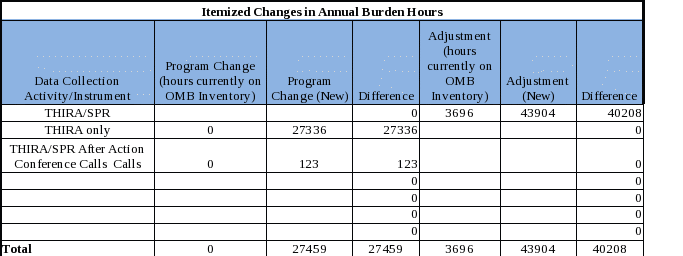Narrative of Changes
FEMA NoC Document Narrative of Changes from Last Submission, OMB Collection 1660-0131, NPAD.docx
Threat and Hazard Identification and Risk Assessment (THIRA) – State Preparedness Report (SPR) Unified Reporting Tool
Narrative of Changes
OMB: 1660-0131
Narrative of Changes
The purpose of the Narrative of Changes is to clearly indicate changes to a collection since the previous approval.
Collection Title: Threat and Hazard Identification and Risk Assessment (THIRA) – State Preparedness Report (SPR) Unified Reporting Tool
OMB Control No.: 1660-0131
Current Expiration Date: 08/31/2015
Collection Instruments: FEMA Form 008-0-19 (THIRA); FEMA Form 008-0-20 (SPR); FEMA Form 008-0-23
The following are the changes to the collection:
FEMA Form numbers have been changed from no form numbers to FEMA Forms 008-0-19 (THIRA), 008-0-20 (SPR), and 008-0-23. This collection effort is a revision of the original collection effort approved by OMB in 2012, titled State Preparedness Report (OMB Number 1660-0131). No form numbers were originally assigned because the original collection tool was an online collection program.
Supporting Statement:
Question 1: Question 1 update explains this package is a revision to the collection originally approved as the State Preparedness Report, OMB Control Number: 1660-0131. The name has been changed to the THIRA-SPR Unified Reporting Tool to more accurately reflect exactly what information is collected and how. It explains that the purpose for the collection remains the same as does what information is collected. The major change was that the collection was divided into two parts, the THIRA and the SPR, to better measure targeted emergency management capability levels throughout the United States and its territories.
Question 2: The original response to this question described the collection’s purpose as a self-assessment of disaster preparedness, performed by each state and territory. The assessment goal and the information collected remains the same but FEMA has adapted how it collects the information through the use of an Excel tool that replaced the online tool to ease user burden when the existing online system failed. It also explains that the respondents originally included only 56 states and territorial governments, but now also includes 67 additional reporting entities comprised of Urban Areas and Tribal Governments.
Question 3: This question addresses the extent of automation that is used for this collection. Since the initial collection tool was a web-based survey tool, the current response explains how that web-based tool previously was slow to respond when too many users were online at the same time. Additionally, using the tool and dealing with response times increased user burden. As a result, FEMA provided respondents the option of using an Excel tool to complete the SPR. Most respondents opted for that option and found it less burdensome. As a result, FEMA adapted its collection tool to be a Microsoft Excel-based tool titled the Unified THIRA/SPR Reporting Tool (URT) to ensure the PKEMRA requirements could be met in a timely fashion. FEMA Federal Preparedness Coordinators email the URT to the respondents annually. States, territories and tribes then fulfill their requirement by completing and submitting their URT to their FEMA Federal Preparedness Coordinator via email, and FEMA stores the information on its shared drives.
Question 8a: Updated to reflect current FRN publication information.
Question 10: Updated to reflect current privacy information.
Question 12: Number of burden hours increased. See Question 15 for explanation.
Estimated Annualized Burden Hours and Costs |
||||||||
Type of Respondent |
Form Name / Form Number |
No. of Respon-dents |
No. of Respon-ses per Respon-dent |
Total No. of Responses |
Avg. Burden per Response (in hours) |
Total Annual Burden (in hours) |
Avg. Hourly Wage Rate |
Total Annual Respondent Cost |
(Urban Areas) or Tribal Government |
THIRA / FEMA Form 008-0-19
|
67 |
1 |
67 |
408 hours |
27,336 |
$45.33 |
$1,239,140.88 |
State or Territory |
SPR -THIRA / FEMA Form 008-0-20 |
56 |
1 |
56 |
784 hours |
43,904 |
$45.33 |
$1,990,168.32 |
THIRA/SPR After Action Conference Call |
FEMA Form 008-0-23 |
123 (same as the participants above, no additional participants) |
1 |
123 (again, same as the participants above) |
1 hours |
123 |
$45.33 |
$5,575.59 |
Total |
|
123 |
|
123 |
|
71,363 |
|
$3,234,884.79 |
Note: The “Avg. Hourly Wage Rate” for each respondent includes a 1.4 multiplier to reflect a fully-loaded wage rate.
Question 14: Costs to the Federal Government updated.
Question 15 – Burden hour increase explained.
Insert full explanation and chart from 15 as highlighted below.

Annual Burden Hours Explain:
This method yields a total hourly burden of 785 hours for each of the 56 States and territories that complete THIRA/SPR, for a total hourly burden of 43,960 hours for states and territories. The respondent burden for completing just the THIRA is 409 for each of the 67 urban areas and tribal governments, for a total burden of 27,403. Combined, the total respondent hours for THIRA/SPR and THIRA only are 71,363 hours. This is an increase of 67,667 hours over the 3696 hours currently on the OMB inventory.
The one program change that impacted the burden associated with the data collection is that FEMA now requires urban area and tribal jurisdictions to complete the THIRA as a condition of receiving preparedness grants. This increases the number of jurisdictions completing that part of the information collection by 67, and thus increases the total hours burden by 27,403 hours (67 jurisdictions times 409 hours per jurisdiction).
| File Type | application/vnd.openxmlformats-officedocument.wordprocessingml.document |
| Author | jramsayj |
| File Modified | 0000-00-00 |
| File Created | 2021-01-24 |
© 2026 OMB.report | Privacy Policy